TBA Day 3: Christeene Recap + Nora Chipaumire Talk
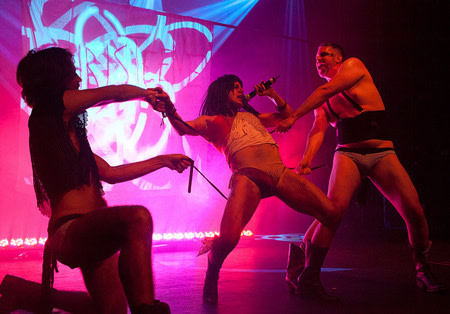
Christeene's raunch-fest of a show last night was electric. I've seen her before in dirty clubs and backyard concerts, but she stepped up to Washington High School's fancy light show and owned the stage. She's ready for a stadium, although I doubt there's a stadium ready for her: it had to be the dirtiest thing ever seen at the Works. After one of the jock-strap wearing performers basically sat on an audience member's face, PICA artistic director Angela Mattox leaned over and said, “I hope none of our board members brought new donors tonight”
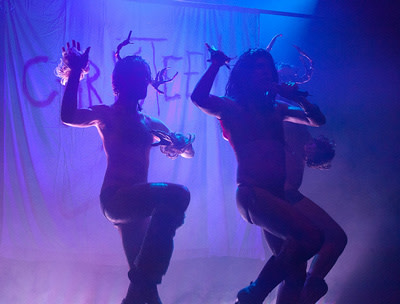
Christeene closed with the song “African Mayonnaise.” Her back up dancers, wearing reindeer horns and furry leggings and bracelets, carried her out and then pranced across the stage like synchronized show ponies. I haven’t been able to get its opening verse out of my head: “I am your new celebrity. I am your new America. I am the piece of filthy meat that you take home and treat to yourself.” I talked with the artist Paul Soileau about the criticism he’s trying to make of celebrity culture yesterday (read the interview here), but we didn’t have time to get into the racialized elements of the song and his performances, although I'd venture the guess it's partially in response to the idea that one of the few places black women can be vaunted as successful in American society today is as sexualized RnB and pop starlets—our modern take on the colonial, racialized, exotic fertility trope—but only as long as they're whitewashed enough for white America.
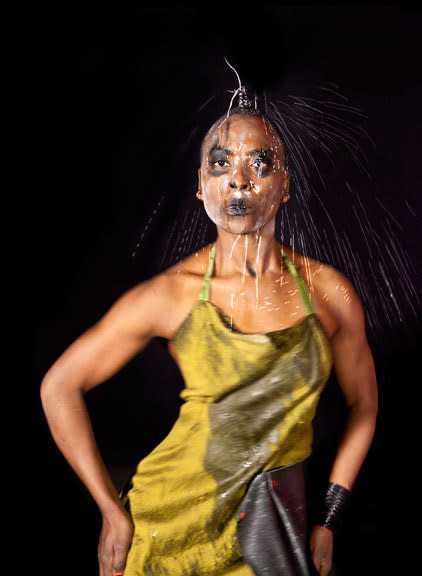
Christeene’s aggressive, satirical, music-video-style assault on that trope couldn’t dance in starker contrast to New York-based, Zimbabwean-born dancer Nora Chipaumire's examination of somewhat similar issues in her performance, Miriam, which takes it’s name and inspiration from the Virgin Mary, the sister of Moses, and the South African singer and icon Miriam Makeba. I wasn’t able to make Chipaumire’s performance last night (looking forward to her final show tonight at Lincoln Hall at 8:30), but I did just sit in on her conversation with Mattox at the PICA office. Much of the conversation focused on the experience of being identified as an “African artist.” Here are some of the highlights:
On falling in love with modern dance upon moving to American, but then having to reconcile it with her African heritage.
I immediately fell in love with modern dance. American modern dance to me, the pioneers—Martha Graham, Doris Humphrey—they just spoke to me. Everything they were talking about landed so well on my body and psyche. This is the thing I want to do [takes on the affected voice of an artiste]: explore my inner landscape.
I am not American. I have citizenship and live here, but I’m not of American history and geography. I’m Shona—Zimbabwe. How can I impose that on this thing called modern dance that’s been created by women? It was a huge tension for me: how can I embody all this stuff and still be honest to myself. I got quickly involved with African American dance companies. But there, too, I began to understand that I was clearly not of this huge world called “black” [laughs]. I had to be really careful not to just adopt. Perhaps what I needed to do is adapt, but I couldn’t adopt over certain things of my being. So the question of how can I be in this form called “the dance” and be Nora Chipaumire from Zimbabwe is an issue that underlines all my works and I carry personally in everything I do.
On the category of “African,” which ignores the immense diversity of the continent, and being identified as an “African artist.”
I am Shona, I am Zimbabwean, I am African. I think when you live in America like I do, it becomes necessary to claim that, because otherwise I’m a “black artist,” and what is that? It’s another box that has pluses and minuses. I think the Africaness is not something I want to make excuses about. It’s a reality. What I’m interested in is the work. Everyone is affected by where they come from. Martha Graham was in search of America. The West seems to forget. You take it for granted, and it’s the “other” who has to stake and prove who they are. I’m not interested in fighting that battle over and over. I’m not going to change. I am African, and I make work, and it must live in this international world and it must meet those standards. That standard is not less for African artists. It’s the same standard for anyone, any self-respecting person with a creative imagination. If I were any lesser, you wouldn’t have me here. I don’t think the art world works on pity, or aid. It’s a brutal world.
On making work that’s not just responsive to western ideas:
Part of having been colonized is to always be doubting one’s self worth. It’s a constant struggle. But I want to make work that my grandmother would understand.
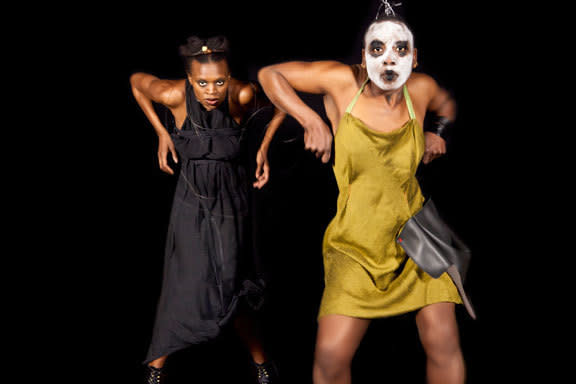
On the creation of Miriam:
The seed of it was planted in my heart and head and body when I heard that Miriam Makeba had died. I had taken her as this icon that would always be there, like Gandhi. It was more about ideas than the physical body, so I suddenly realized she was human and could die.
I started thinking about what does that mean to sustain a life of art, and as an African girl coming from an African family that’s probably more traditional than mine. I was thinking how much it took for her to become Makeba. With that kind of stature, there was a price to pay. I was really curious about that. But I didn’t want to do another “Fela” type thing, even though Makeba has a very good story…it’s ripe for Broadway. But I wanted to honor the way women deal with issues, especially women who also happen to be in the public eye. This special burden that Makeba carried: she was Mother African. Did she ask for this?
That led me to the Virgin Mary. What are the requirements of women? What is the way of femininity? I’ve always been met with “[Makeba’s] fierce, she’s strong, she’s angry, she’s an angry black woman.” That’s part of the baggage I have, and I can be angry too [laughs].
So Virgin Mary led me to Moses’ sister, who sang and danced and led a rebellion. It led me to these Miriams. Makeba had to be obstinate to sustain her self through the ups and downs and burdens of being Mama Africa. In that, there’s this biblical thing, Makeba was in exile for 30 years, kind of like Moses wandering in the desert for 40 years.
It’s really fascinating because I’ve lived out of Zimbabwe for almost 20 years and there’s a huge guilt I feel about that. Clearly there’re others that don’t have the privilege to leave Zimbabwe. There’s the question of what is lost and what is gained? It’s the burden of freedom: I have the freedom to do my work, but I have huge anxiety about my mother and family that live in Zimbabwe.
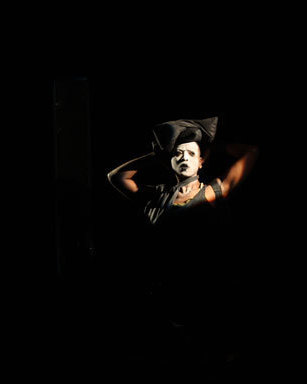
On dealing with the black body:
I grew up thinking that the only bodies that were worthwhile had blond hair and looked like Wonder Woman. There’s something about trying to come to terms with my own body as a daily reality—coming to terms with my own body and certain other powers that exert themselves. You would think people who are in the public gaze have to deal with that quite often. Makeba had to deal with that when she grew older and fatter.
The black body is in the trenches. It’s a body that we think we’ve come to terms with, and yet it continues to have questions and tensions. I think the African black female body has been less addressed in art…I think the African female body is completely invisible, so I’m trying to bring it a certain visibility with it’s inherent tensions and questions and insecurities too. Not just as a mother: Mama Africa, but not as a sex symbol. [But there’s] very few exceptions, like Imam, that matter.
On the impact of Joseph Conrad’s The Heart of Darkness:
I had the experience to go up the Congo River and see what Joseph Conrad experienced. It was nothing; it was just a river! It’s much more developed clearly than when he was there. His manner with language—Joseph Conrad brought up so many images. There’re shadows that he talks about. I wanted to capture that feeling of the darkness…The heart of darkness, which implies a fear. Clearly Joseph Conrad was undone and done at the same time. “Whoa, savages!” There was something of trying to address the Baroqueness, the fears, the whole Belgian expedition into the heart of darkness, and trying to then capture light. The whole thing we fear about Africa—the unknown. We can go on safaris and have fun, but the people are “other.” I wanted to deal with that.
On the elements of ritual in Miriam:
I describe it as both a ritual and a crime scene. So whichever one gets you to the right space. I think there’re a lot of clues, too, in the sound score, because Omar [Sosa, the composer], too, is very much invested in spiritual practices. What you do miss unfortunately with the proscenium stage is a clear comprehension of how the space is designed in this ritualistic way. If you’re closer to it, you’re able to decipher certain things in it, or not, in the round with the four points. And what that means to anybody, it’s up to you what that means, but it’s not wrong to think of it as a ritual.
It would've been mighty interesting if Christeene's Paul Soileau would've been sitting in on the conversation, too, as he was equally thoughtful but obviously coming from a very different background. Fantasy roundtable discussions aside, I’m looking forward to seeing Chipaumire's performance, which will also stand in stark contrast to Miguel Gutierrez’s performance tonight, too, I imagine. And then it’s off to Night 3 at the Works, the annual audience favorite: Ten Tiny Dances. Unlike in years past, though, every artist is new to the tiny stage tonight, including some of the highlights of the fest, like Gutierrez, Keith Hennessy, and Chipaumire’s co-performer, Okwui Okpokwasili.
